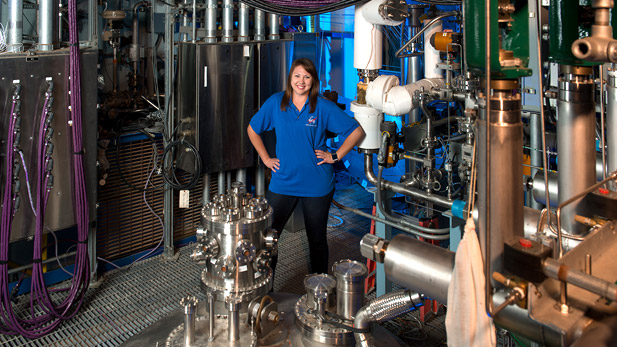Alumna Monica Guzik Has Cool Job, Taking Science from NASA’s Cryogenic Lab to Space
Wednesday, June 23, 2021

Chemical engineering alumna Monica Guzik has helped develop award-winning technology since joining NASA’s Glenn Research Center after graduation. One of her innovations will be sent to the International Space Station this summer.
You would think that working at NASA would be cool enough, but it gets even cooler, literally, for 2010 chemical engineering alumna Monica Guzik, whose award-winning cryogenics work is making long-duration space exploration possible.
Guzik has spent most of her career as a gas and fluids system engineer at NASA’s Glenn Research Center outside Cleveland, before being promoted in early 2021 to the Office of the Chief Engineer to oversee a variety of highly technical, out-of-this-world projects.
Cryogenic rocket propulsion systems rely on the combustion of a cryogenic fuel, typically hydrogen or methane, as well as oxygen to provide thrust. It’s a process advocated by Rose Polytechnic mechanical engineering graduate Abe Silverstein that propelled America’s space program.
Today, the revolutionary Hubble Space Telescope has sensors that gather data at near-absolute zero temperatures while propellants for human exploration missions to the moon and Mars must be stored for several years to make long-term missions possible.
“In cryogenics, the environment is almost always warmer than the propellant, even on the dark side of the moon, which reaches a surface temperature of negative 183 degrees Celsius during the lunar night,” says Guzik. “Technology development is always exciting – finding new ways to accomplish new things or to do something better, faster or cheaper is always rewarding. NASA is pushing the envelope in all those areas – with humans on Mars being our ultimate goal. There are a lot of challenges to solve to get there.”
Guzik received NASA’s Early Career Achievement Medal in 2016 for leading efforts to develop advanced fuel cells for a power system on a rover. A year later, she earned a NASA Silver Award for further fuel cell applications on the upper stages of cryogenic rockets. Another engineering honor resulted from developing hardware demonstrating the elimination of cryogenic boil-off during a mission.
Now, Guzik’s work to develop a facility to obtain two-phase flow boiling and heat transfer data in microgravity is scheduled to be sent to the International Space Station on August 1. She will join family, including her younger sister, 2012 optical engineering alumna Carolyn Guzik, for the project launch.
“It is extremely rewarding to be able to take a technology from a laboratory environment, develop that technology into something that can be applied to an actual NASA mission, and then see the technology actually become baselined for use in a future mission,” Monica says. “Being able to work with the scientists and technologists to make their innovative ideas come to life, and then to work with mission planners and leaders to showcase these ideas as they may apply to a future mission, is really incredible. And, it is really amazing to imagine that hardware that I helped design, assemble, and test – that I’ve actually physically helped put together – will be flying on the International Space Station.”
Guzik has spent most of her career as a gas and fluids system engineer at NASA’s Glenn Research Center outside Cleveland, before being promoted in early 2021 to the Office of the Chief Engineer to oversee a variety of highly technical, out-of-this-world projects.
Cryogenic rocket propulsion systems rely on the combustion of a cryogenic fuel, typically hydrogen or methane, as well as oxygen to provide thrust. It’s a process advocated by Rose Polytechnic mechanical engineering graduate Abe Silverstein that propelled America’s space program.
Today, the revolutionary Hubble Space Telescope has sensors that gather data at near-absolute zero temperatures while propellants for human exploration missions to the moon and Mars must be stored for several years to make long-term missions possible.
“In cryogenics, the environment is almost always warmer than the propellant, even on the dark side of the moon, which reaches a surface temperature of negative 183 degrees Celsius during the lunar night,” says Guzik. “Technology development is always exciting – finding new ways to accomplish new things or to do something better, faster or cheaper is always rewarding. NASA is pushing the envelope in all those areas – with humans on Mars being our ultimate goal. There are a lot of challenges to solve to get there.”
Guzik received NASA’s Early Career Achievement Medal in 2016 for leading efforts to develop advanced fuel cells for a power system on a rover. A year later, she earned a NASA Silver Award for further fuel cell applications on the upper stages of cryogenic rockets. Another engineering honor resulted from developing hardware demonstrating the elimination of cryogenic boil-off during a mission.
Now, Guzik’s work to develop a facility to obtain two-phase flow boiling and heat transfer data in microgravity is scheduled to be sent to the International Space Station on August 1. She will join family, including her younger sister, 2012 optical engineering alumna Carolyn Guzik, for the project launch.
“It is extremely rewarding to be able to take a technology from a laboratory environment, develop that technology into something that can be applied to an actual NASA mission, and then see the technology actually become baselined for use in a future mission,” Monica says. “Being able to work with the scientists and technologists to make their innovative ideas come to life, and then to work with mission planners and leaders to showcase these ideas as they may apply to a future mission, is really incredible. And, it is really amazing to imagine that hardware that I helped design, assemble, and test – that I’ve actually physically helped put together – will be flying on the International Space Station.”